Royal Champagne Hotel & Spa, Champillon

Over Christmas 2019 we decided to spend a few days relaxing in the 5-star Royal Champagne, a hotel and spa located in Champillon in France. Champillon is a small village sitting between the city of Reims and the town of Épernay, so it's situated in the heart of the Champagne region.
I know we should always be careful when reading hotel brochures and reviews, but we could not resist "Perched high on a vine-clad hill with sweeping views over the unspoilt Marne Valley is this historic coaching inn, refashioned into a gleaming modernist shrine to the Champagne region that surrounds it. Interiors are light and effervescent, the food is sensational and the spa is a destination in its own right."
This is quite an extensive report, but we can summarise quickly our overall conclusions. We found the rooms, the overall decoration, and the level of service corresponded to what we expected from a 5-star hotel. Room service meals were fine, but the special Christmas dinner was a little bit disappointing. For us the real disappointment was that when you book an expensive hotel over Christmas you hope for a memorable experience. Our stay was fine, but nothing more. Would we return? Why should we, there are many other options in and around Reims! The Royal Champagne Hotel & Spa did not have the wow factor.
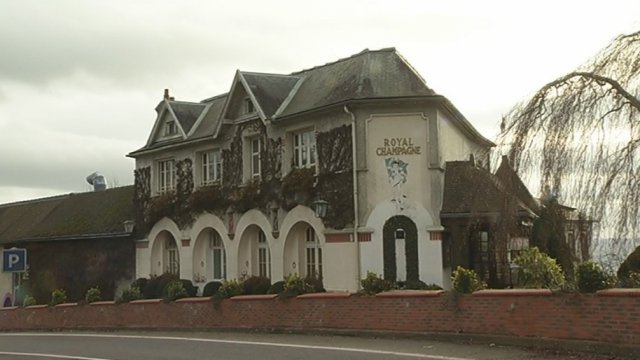
My understanding is that there has been a hotel and restaurant on the site for some considerable time. It was once owned by the group LVMH before being bought by an Italian group. As far as I understand things the hotel closed in 2014, and was subsequently bought for a major renovation project. The original hotel building was a 19th C Relais de Poste (coaching inn), and the new owners quickly added a modernist wing and wellness centre. The site architect was Giovanni Pace of Reims and the decorator was the designer Sybille de Margerie. The result is a kind of amphitheater offering impressive views over a wine-producing valley from its 49 rooms and suites.
The new hotel reopened in July 2018, and its restaurant 'Le Royal' has 1![]() Michelin 2019.
Michelin 2019.
I made the booking directly with the hotel, but the Booking website gives the hotel a 'wonderful' 9.3 and 9.7 for location, however Trip Advisor only gives the hotel a 4.5 out of 5. The website of the hotel is oddly clumsy, as if designed to impress and ending up just being a bit confusing and messy (totally not 'fit for purpose').
However my phone and email contact with the reservation department (Camille Vannienwenhove and Margaux Depinoy) was perfect. Franky, I would never have booked just using the hotel website, and it would probably have convinced me not to book through an agent such as Booking. It was the prompt and efficient replies, etc. of the reservation department that saved the day.
According to a few of the rather superficial descriptions, when the old 'Relais de Poste' closed it was more or less immediately bought by the Boston-based Champagne Hospitality collection, a group of boutique hotels that includes Le Barthelemy in St. Barths. Frankly the website of Champagne Hospitality leaves a lot to be desired. They 'create moments worth treasuring' and mention Los Angeles-based services such as yacht charter and vegan foods, and nothing about hotels or champagne. Frankly, I would steer well clear of the website.
However other reports mention that the hotel was purchased by Boston financier Mark Nunnelly and his wife Denise Dupré. The story goes that they invested €25 million in the 2-year renovation project. Naturally other stories suggest that it took 3 years and cost €50-60 million. One of the stories mentioned that Mark Nunnelly founded with Mitt Romney an investment fund called Bain Capital. This was the Mitt Romney that was a US Republican Party nominee for the 2012 presidential elections. However the Wikipedia article on Bain Capital makes no mention of Mark Nunnelly. Other references have him as a managing director at Bain Capital in the period 1989-2014, and The New York Times suggested that Nunnelly was not prepared to commit to building a new round of investments in 2014 (so I guess he quit to do something else). There are references indicating that Mark Nunnelly was the secretary of the Office of Technology Services and Security for the Commonwealth of Massachusetts, and before that was commissioner of the Massachusetts Department of Revenue and was special advisor to the Massachusetts Governor Charlie Baker (a Republican). Mark Nunnelly is also referenced, as of June 2018, on the Board of Directors of the Broad Institute, which was founded by MIT and Harvard to use genetics to improve the treatment of diseases. Mark Nunnelly appears as investor and director on a number of US-based companies, and according to one website his net worth exceeds $4 billion.
According to some accounts the wife of Mark Nunnelly is Denise Dupré, (ex-)Dean of Boston University (other reports mention her as Professor of the Chair of Hospitality). She is registered in France as 'directing' 9 companies, and in particular she is president of both the company Royal Champagne since 2003 and Leclerc-Briant since 2012.
Now Leclerc-Briant is a champagne house dating back to 1872. It was founded by Lucien Leclerc, and the name derives from Bertrand Leclerc and his wife Jacqueline Briant, who took over in 1955. They were early adopters of 'la culture biologique', i.e. organic farming. In 1978 Pascal Leclerc took command and in the 1980's he converted the production to the so-called 'biodynamie', i.e. biodynamic agriculture. Setting aside the more mystical aspects of this, what we are talking about are things such as biological pest control and the use of natural or organic fertilisers, and avoiding all synthetic fertilisers and pesticides. Unfortunately Pascal Leclerc died in 2010 and his four daughters could not see a way to continue production (after paying inheritance tax). So they sold half of the 'vignoble' (15 hectares) to Bruno Paillard, for his own production, and the other half went to the house Roederer, who quickly sold on some assets to the couple Nunnelly-Dupré. It would appear that the new owners then handed over production to Frédéric Ziemett and the oenologe Hervé Jestin. Jestin is a specialist in biodynamic production, and owner of his own vintage Champagne brand (here is an interesting article on Justin and biodynamic production). Zeimatt was with Moët and, as far as I can tell, is responsible for converting the domain into a 'bio-chic' Champagne house (certified vegan). One article even mentioned that Leclerc-Briant had passed from 'bio-cheap' to 'bio-chic'. With Pascal Leclerc production had dropped to 30,000 bottles, sold at €12 each. Nunnelly-Dupré bought the name, the original buildings and a small piece of land, and they recovered 150,000 bottles from Roederer. Roederer also allocated some hectares of old vines, and they manage to pull together a group of suppliers of biodynamic grapes, so they could finally relaunch production.
After the re-launch of Leclerc-Briant and the re-building of the hotel Royal Champagne, the couple Nunnelly-Dupré have turned their attention to another wine producing area in France. They have bought the Château de la Commaraine in Pommard, in the Côte de Beaune region (and it includes a Pommard premier cru). Their plans are extensive and include a hotel and spa, a restaurant, and the purchase of the 'maison de négoce' Le Manoir Murisaltien-Demessey. It is said that the couple spent more than €30 million in the Bourgogne region.
Finding the hotel
The drive to the hotel was uneventful, even if the weather was not at its best. We left the A4 motorway and took the 'Voie de la Liberté', the D951, towards Champillon. Our car gps understood the address, Rue de la République, but not the number 9. We took the exit 'Le Vertin', the D251, expecting to spot the hotel as we drove towards Champillon. Checking out the site on Google Maps did not really help because the hotel is still a building site (the satellite image must date from 3-4 years ago).
Later I spotted the exit on the D251, but the first time along the road I missed it. The problem is that when the system does not recognise the number then it takes you to the beginning of the road, and naturally the hotel is situated at the end of Rue de la République. I challenge you to spot the road sign for the hotel.

I must admit that I did not spot the sign post, so a little more effort is needed there.

As I drove past the hotel, I did not imagine that it might be our 5-star destination. So we continued down the D251, then into the village, and out again on some un-named local tracks, and finally on to the Rue de la République. Driving up the road it was not difficult to see the entrance to the hotel, which now looked quite obvious.

The welcome was friendly and well organised. Bags were taken and the car was parked. They told us that during the day the car would be in the front parking area, but at night it would be placed in a closed secure parking.
Reception was again friendly and we were shown to our room with the minimum of hassle. Bags arrive minutes later, and we could get ourselves installed.
The room
The hotel provides a range of room options, but we stuck with the simplest of rooms. On the hotel website many of the rooms options look very similar, so we picked the room that appeared to us to be ideally placed on the ground floor with a view overlooking the vineyards in the valley.
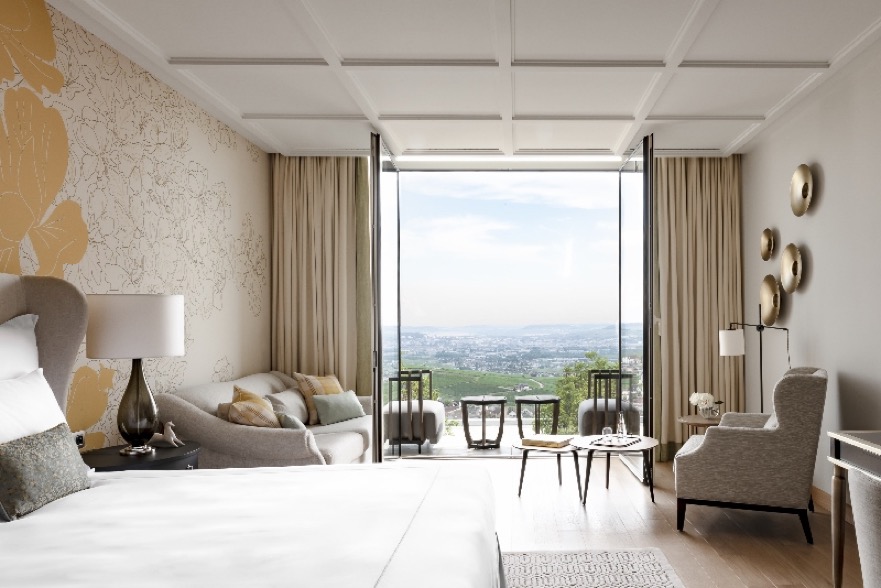
Our room consisted of a large bedroom area with a large double bed, a sitting area in front of a large window with a view over the valley. The above photo was taken from the web, but it looks identical to the room we had. The only different I can see is that we had fewer cushions on the divan, and the small cushions on the bed were red. We had a small sitting terrace furnished as seen above.

As you can see the colours a quite muted, the wood is a natural oak, and everything looks hand-crafted and new. The fabric wallpaper has a vine inspired design, and ours was marked out in a pale red rather than a pale yellow. In terms of visual impact on entering the room I would only have one suggestion. In the summer I'm sure that the big ceiling-to-floor picture window provides all the visual impact needed, but in the winter with a grey rainy sky, the room looked just a bit dull. In the corner with the bed its fine, but I think some more warm vibrant coloured cushions on the seats would be a nice winter touch. Also the designer could have been a bit more adventurous with the wall of curtains.
The furnishing are of a very high quality, as was the bed linen etc. In front of the bed there is a nice big desk (much appreciated) and a good size flat-screen TV. It has a wooden 'frame' but the TV is articulated and can be moved to provide a good viewing angle to the seating area. And next to the desk was a solid suitcase stand.
On the small side tables in the sitting area we found two oranges, and a bottle of Evian with glasses. In addition there was a large box containing two Champagne flutes, and a bottle of Leclerc-Briant sitting in an ice bucket. We drank the bottle with our evening meal, which we ordered in the room. The next day (the 24th December) we found a few lychee and three small cakes with a little chocolate Christmas tree (but no second bottle of Champagne). Setting aside the Champagne, two oranges and a few small cakes lacked the sense of abundance that one might expect from a luxury 5-star hotel.
During the booking I had asked about a few things that might adversely affect my wife. She had a problem with her back and we did not want a bed that was too hard, etc. In fact they had very kindly added a soft mattress and pillows specifically on our request. An excellent gesture. Another good point was that there was no bed throw that is useless and just collects dust.

As we entered the room we found a short corridor leading to the bedroom. On the left there was a good sized and very well equipped bathroom. On the right there was a separate WC with handbasin. Then there was a small walk-in wardrobe space, and finally a small cupboard space with fridge, etc.
The small walk-in wardrobe area was well equipped with shelves, draws, and a wall safe. Two very positive points were the large wall safe (big enough for computers, etc.) and the multitude of good quality coat hangers. My wife hates it when she finds just a few of those coat hanger that are permanently attacked to the rail, or those that half detach to avoid theft.

Before entering the bedroom there was a cupboard area with an illy coffee machine, and a draw with illy coffee capsules and Jing teas. Below the coffee machine there was a small fridge with complementary drinks, with water, Coca Cola and orange juice. The fridge was replenished daily.

The good sized bathroom consists of double limestone basins, a free-standing bath tub, and large walk-in shower. Naturally toiletries were from Hermès.
Both the bathroom and bedroom itself could be closed off with very stylish floor-to-ceiling wooden sliding doors.
So lots and lots of positives about the room, with a beautiful design, great quality bed and furnishings, etc., and a nice view across the valley. I even detected a light scent in the room and on the bed after cleaning. Very agreeable.
What about negatives, we always have to find some negatives. The decor could be livened up a bit during the winter, but I don't really consider that a negative. But I did find a couple of things.
First in the room there were two bathrobes, and naturally the hotel fell into the classical trap. They had put an XL and Medium, which was good thinking. But the problem is that hotels order the sizes without taking into consideration shrinkage when washed at 60°C. So we had an XL that was a big-medium (and a bit tight for me), and a Medium that was a real small (great for my wife).
The second negative comes also with a positive. First the positive, there was a multitude of electricity sockets perfectly spread throughout the apartment, and including 2 USB charging points. The negative was that the light switches were incomprehensible. I gave up trying to figure out how they worked and which lights came on or switched off as a function of which switch.
The hotel reception areas
The central area of the hotel covers three floors, the entrance and reception area on floor 2, the bar and restaurant on floor 3, and a large double-height sitting area on the ground floor (floor 1) called the 'Salon Fines Bulles' (and including a small library area).
The entrance and reception area is functional, and is also home to a small shop that is not worth a visit. Frankly, the reception area lacks 'impact', something so important is a luxury 5-star hotel.

The 'Salon Fines Bulles' is a very pleasant double-hight room with a glass Champagne storage vault, a big fireplace, and very impressive modernist crystal chandelier from Swarovski. I saw a report suggesting that some of the other light fittings came from Giopato & Coombes.
The negative is that the reception area and the 'Salon Fines Bulles' lacks warmth and are not really invitational. Even with the Christmas decorations people would walk through, take a photo, and move on. The space is well adapted to creating an 'experience' but there was no attempt to create one. For example the large fireplace in the 'Salon Fines Bulles' was never lit even over Christmas, and the smaller fireplace in the reception area was lit on the 23rd December when we arrived, but not on the 24th, 25th or 26th December.
Interesting the library was a kind of extension to the 'Salon Fines Bulles' and provided access to the large lower-floor terrace (being different from the roof-top terrace accessed through the bar and restaurant area of the 3rd floor). What was interesting was that, for once, it was home to some attractive books.
The bar and restaurant area
The bar and restaurant area is on the top floor (3rd floor). The hotel has two restaurant, the 1

Upon arriving we took tea and coffee in the bar. The tea was fine, but the coffee was just a small cup that was finished in 5 seconds. We ordered a chocolate type dessert from the bar menu, which was well presented. The reality is that the bar itself is fine, but the staff are slow and a bit snobby, and the prices are a touch excessive for what was a very unmemorable experience. Shame, you might go there because your thirsty, but certain not for the 5-star 'experience'.
The breakfast
Now breakfast in interesting, in part because it has attracted some criticism in the past. Breakfast is taken in the restaurant 'Le Bellevue', and next to the bar. There is a small table with several types of breads and jams. And there is a main service table with a complete and varied buffet. It is easy to compare this buffet with other 5-star hotels. The first point of comparison might be on the variety on offer, and the second point might be on the extent of the offer, i.e. how much salmon or cheese is placed out at any time.

Firstly, it is clear that this buffet does not offer 5 varieties of cheese, 10 varieties of cereals, many varieties of eggs, bacons, etc. However there is a good variety of options on offer. What is more, I personally appreciated that only a small amount is placed out at any time. In some hotels one is left asking what they do with all the food on the breakfast buffet that is not consumed.
Based purely on our own experience I appreciated the freshly pressed orange juice, the scrambled eggs and sausages, and the brioche with the butters and jams.
I would have four negative comments. Firstly, I personally would have liked to see a greater variety of pre-prepared fresh fruit, and not just one macedonia-like fruit salad. Secondly, you can see in the above picture the purple velvet chairs. They are placed along the window and are thus in a prime position, however they are so low that they are incredibly uncomfortable. Thirdly, you can serve yourself everything but tea and coffee. These are ordered from the bar, and take ages. I want my flow of coffee in the morning immediate and continuous. I hate having to asked for a coffee, then wait ages, then see it arrive on a tray, and then drink it and have to wait to order the next. This is coffee not ambrosia.
Finally, the breakfast was included in our Christmas package, but I can understand people finding €39 a bit steep.
The restaurant
We spent four nights in the hotel and took our evening meal relaxing in our room. Three of our evening meals came from the room service menu (offered 24/7). My wife tried the seasonal vegetable soup, but found it a bit too creamy, salty and rich. She enjoyed the foie gras, but I found it very average. I also found the club sandwich decidedly under average compared to what you can find in any decent golf club (for half the price). However we both enjoyed the Cesar salad.
Included in our Christmas package was a dinner on the evening of the 24th or a lunch on the 25th December. We went for dinner on the 24th December. It was a fixed 5-course menu to which I added another bottle of Leclerc-Briant Champagne.
The hotel was very accommodating in that it organised the full menu service in our room, with four back and fourths for the different courses. Room service staff were excellent throughout our stay.
The menu for dinner on the 24th December 2019 was as follows:-
Amuse-bouche
A nice start with a coupe de Champagne
Foie gras de la ferme du Puntoun, brioche maison, fine gelée de mandarine et quinoa
Good, lovely preparation and nice accompanying textures and tastes
Noix de St Jacques dorées au sautoir á la betterave, émulsion champagne rosé
Very good, and loved the Champagne emulsion
Chapon de Bresse aux marrons, gratin de salsifis et pommes soufflées, jus court acidulé
Was let down by a chunk of capon without any real impact, and I did not like the preparation with the chestnuts, too little sauce
Pré-dessert
Flocons de neige au yaourt et gingembre kakis à l'huile d'olive vanillée
Not bad, but was not the crowning dish of a Christmas dinner
Overall: not bad, but over priced and did not create a memorable Christmas experience. Lucky I added the bottle of Leclerc-Briant Champagne.
The terraces
There are two large terraces (for a total 1500 m2), one in front of the rooms (see below) and the other a roof terrace opening out from the bar and restaurant on the 3rd floor. We can see the amphitheatre style of the building. The architecture is functional more than inspiring. Our room was on the lower floor nearer the far end in this picture. The weather was uninspiring so its difficult to complain about the terrace, and it might look completely different in summer. However I felt that they had missed the point with these terraces. If a hotel is to be all-seasons then the terraces must also be useful in all seasons, e.g. why not some seats around a big fire-pit?
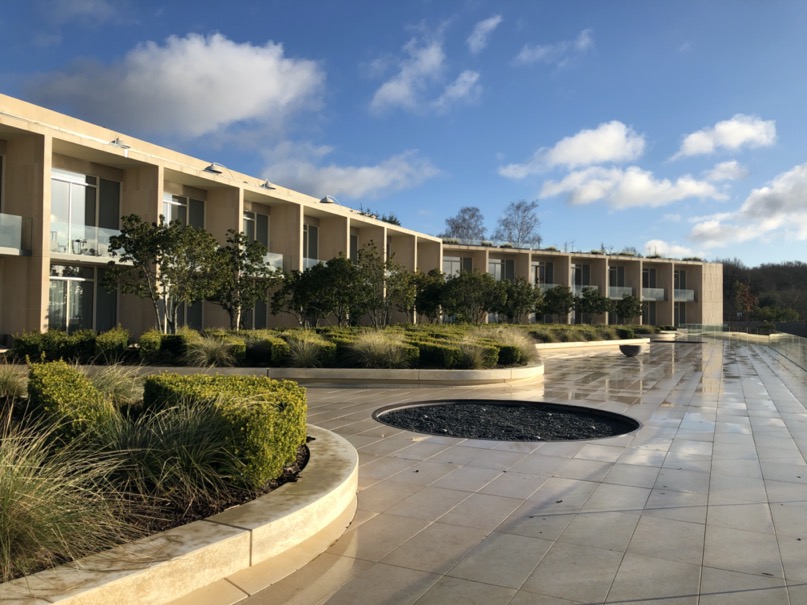
The spa
The spa and wellness centre is sold as a major asset of the hotel, and rightly so. It is said to cover a total 1500 m2 and includes a 25 m indoor pool, kept at 29°C. There are two jacuzzi's, a sauna, and a 1-room hammam. I'm not able to comment on the wellness treatment, but a number of reviews rated it positively. My wife had an excellent manicure.

My comments are reserved for the sauna and hammam, however the pool and jacuzzi's were just as you would expect.
I was disappointed with the sauna. The temperature was set at around 75°C and I expected it to be 90°C. It had an electric heater so there was no way to change the temperature. Despite there not being coals in the sauna there were warning signs in the sauna about the coal heaters! On the other hand there were no health warnings, no instructions for first time users, and no emergency button in the sauna. In addition there were no showers in the entry area to the sauna. The sauna was poorly conceived for a 5-star spa and wellness centre.
Concerning the hamam, I have nothing but good comments. Excellent temperature, good showers in the entry area to the hammam. There was a notice excusing the poor condition of the roof of the entry area to the hammam. The claim that the ceiling would soon be repaired sounded reasonable until you note that there were comments about the ceiling already made in April 2019.
Conclusion
This is quite an extensive report, but we can summarise quickly our overall conclusions. We found the rooms, the overall decoration, and the level of service corresponded to what we expected from a 5-star hotel. Room service meals were fine, but the special Christmas dinner was a little bit disappointing. For us the real disappointment was that when you book an expensive hotel over Christmas you hope for a memorable experience. Our stay was fine, but nothing more. Would we return? Why should we, there are many other options in and around Reims? The Royal Champagne Hotel & Spa did not have the wow factor.
We did notice that some clients had dogs with them. So people might not appreciate this, however I did read that the hotel charges extra for dogs and deep cleans the rooms after use.
With the above I have more or less concluded our review of the Royal Champagne Hotel & Spa. However there are some intriguing questions left unanswered. Below I have tried to treat a number of these outstanding questions, namely:-
When we stand on the hotel terrace and look over the valley towards Épernay, what are we actually looking at?
The fact that the Royal Champagne was once an old Relais de Poste (coaching inn) is often mentioned as a kind of 'big positive', but what does that mean?
There is mention of King Charles X of France having once stopped in a Relais de Poste at Champillon before heading toward Reims for his coronation. Is this true?
The French version of Wikipedia entry for Champillon mentions that Napoléon once stopped there. What more do we know about this?
Inside the hotel a figure on horseback is used extensively as one of the major decorative themes in the hotel, but what does it represent?

And finally on the outside wall of the old Relais de Poste there is a painting of a soldier, but what exactly does that mean?
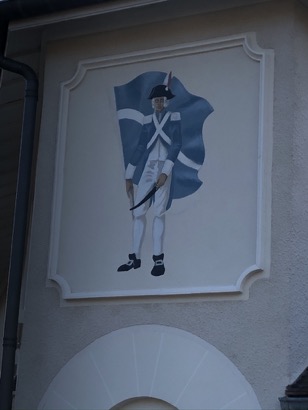
Champillon, Épernay, and beyond
Now that we have completed our review of the hotel we can sit back and consider the views over the valley.

Let us first consider the view from the terrace. We can see the village of Champillon nearby on the left, and in the distance we have the town of Épernay.

Just over to the right (see below) we have the village of Hautvillers, the home of the famous Dom Pérignon, the Benedictine who helped develop the Champagne.
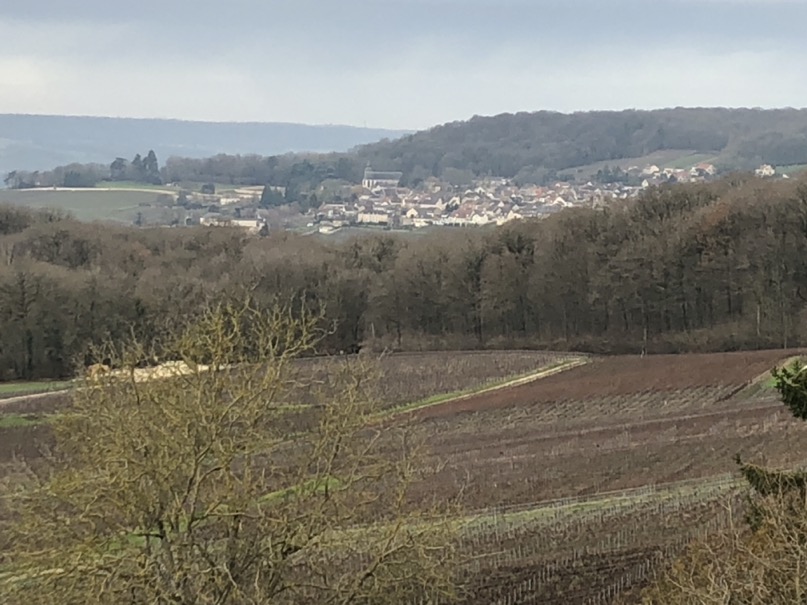
According to the 'échelle des crus', established in the 18th C, there are 294 'crus du champagne' classed in three categories. There are 17 'Grands Crus classés', and there are 44 'Premiers Crus classes', including those in the village of Champillon. The remain 237 production areas are just called 'crus classes', and are only allowed to simple mention 'Champagne' on their bottles. In 2017 there were 15,800 winegrowers in the Champagne region.
The idea of a 'cru' is a way to designate a precise 'vignoble' or piece of land or region of production. And for Champagne 'cru' actually means an entire commune. The idea was to permit growers to fix a price per kilo on grapes being sold to 'négociants'. These buyers purchase grapes for the big Champagne houses, and according to tradition they must guarantee that the grapes they buy are 'sain, loyal et marchand' (sound, fair, and marketable). The way it works is that for a given year a price is decided per kilo of grapes, then each producer receives a percentage of that price. The 'Grands Crus classés' are paid 100% of that price, the 'Premiers Crus classes' are paid between 90% and 99% of that price, and the others are paid between 80% and 89% of that price.
Champagne is usually composed of three grapes, Pinot Noir, Pinot Meunier, and Chardonnay, but you can find some Champagnes that are 100% Chardonnay. Production is quite strictly controlled with a minimum of 8,000 vines per hectare (a hectare is 10,000m2), producing between 10,000 and 15,000 kg per hectare (there is a cap at 15,500 kg/ha for AOC production). Yields will vary depending upon the production techniques, type of grape, weather conditions, etc. so one can only write about averages. One can expect around 85 berries per cluster, and 8 bunches of grapes per vine (figures can vary from 75 to 100 grapes per bunch). Juice extraction is usually limited to about 6,600 litres per hectare ('must' extraction is limited to 102 litres per 160 kg of pressed grapes). The exact pressing equipment and process are strictly controlled by a special 'cahier des charges'. So 680 grapes can be expected to produce up to about 0.8 litres, and therefore a bottle of Champagne might contain the juice from about 600 grapes. Depending upon the proportions of the three varieties of grapes, a bottle of Champagne will contain the grapes from between 6-7 bunches of grapes (or about 1.2 kg of grapes). So if a bottle yields 5 glasses, then there is the equivalent of about 120 grapes in each glass. These figures are used just to give us an idea of what a bottle of Champagne contains. The website Grandes Marques & Maisons de Champagne is a useful source of information.
In addition to the big Champagne houses, there are many, many smaller independent grower-producers or 'vigneron'. Returning to our view of Champillon we can actually see at least four different Champagne producers, namely Champagne Michel Bahuchet Pere et Fils, Champagne Pascal Autréau, Champagne Roualet Pere et Fils, and Champagne Gisèle Devavry. However it is not said that the vines growing infront of the hotel actually belong to one of more of these producers. As an example, the Devavry family collects grapes from Champillon, Hautvillers, Romery, Aÿ, Sermiers, and around Sezanne.
In the minds of many people Champagne is synonymous with Reims, and people tend to ignore the fact that Épernay is the 'capital of Champagne'. In the centre of the town there is the famous Avenue de Champagne where you can find many leading Champagne producers (19 of the larger houses are in this town as compared to the 22 in Reims).

Now returning for a moment to that first landscape, I asked myself what that flat range on the horizon is? And this question opened up the intriguing topic of the French passion with 'terroir', i.e. a place with its own mix of geology, climate and methods of viticulture.
However, the challenge to understand 'terroir' is well beyond the scope of a simple hotel report, and yet I remained intrigued by the landscape before me. For the moment let's just think of 'terroir' as a combination of soil type, slope, drainage, etc. and ignore those who think of it as just another marketing ploy (but if you are really interested in the topic check out "Geology and Wine: A Review").
We start with the 'geological province' in which the Champagne region is found, its code 4040 and defines an extended zone of crust called the Anglo-Paris Basin, in which the better known Paris Basin can be found.
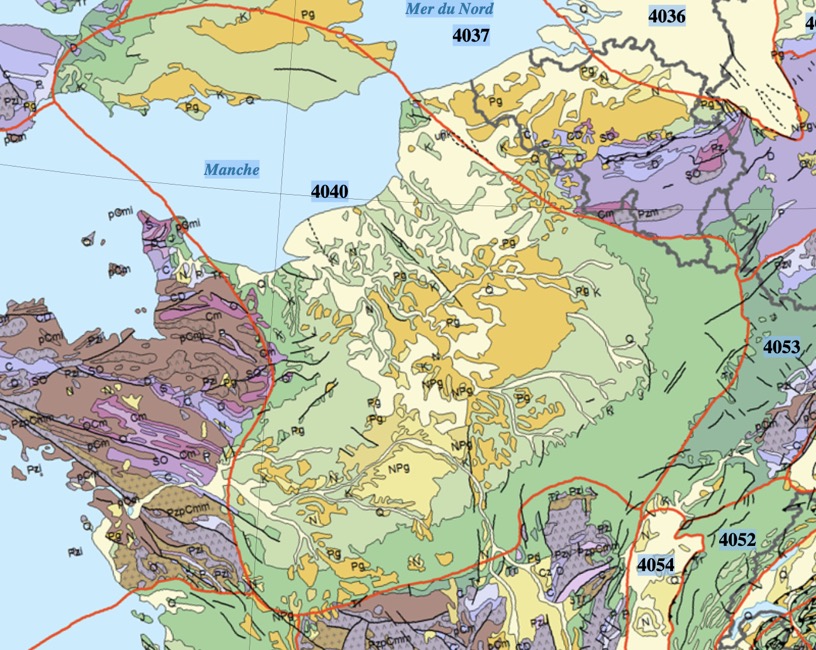
I will not go into how the Basin emerged, but clearly we can see that it is 'jammed' between a series of massifs, i.e. the Massif Armorican, the Vosges, the Ardenne, and the Massif Central.
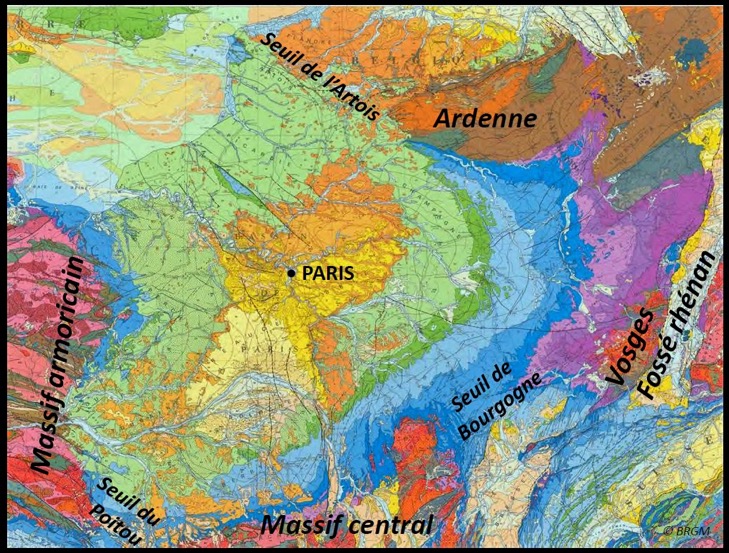
During a period called the Cenozoic (66 million years ago) the early land masses were stretched and opened up to the seas. Large quantities of clastic materials were deposited in basins in repeated transgressions-regressions of the sea (so Late Triassic siliciclastics, Lias-style shales, Doggerland carbonates, and Late Jurassic clays, all predominantly sedimentary rocks). With the return of the sea during the Cretaceous period, chalk was deposited (marine deposits that became another type of sedimentary carbonate rock). In the late Cretaceous period there was a period of widespread uplifting (compression and deformation) which isolated the Paris Basin. The different structural faults became drainage lines that eroded the landscape (and finally became the rivers we know today). For those readers interested in the way to see the geology around us, and in particular in the Paris Basin, check out the blog 'Written In Stone'.
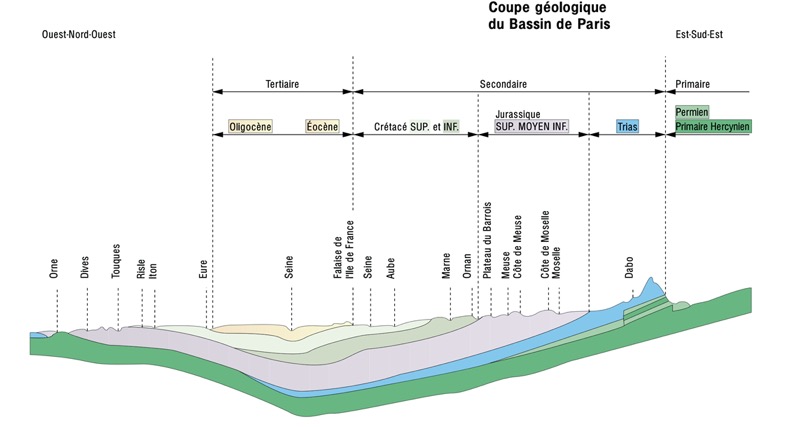
The result of those millions of years is seen in the above cross-section through the Paris Basin. And we can see that the Champagne region sits on a sub-soil from the so-called Lower (Early) and Upper (Late) Cretaceous periods. As we move from Paris (Seine) towards the East and the Jura we are going back in time, from the most recent towards the oldest deposits.
In fact the geology of the champagne region is divided into Champagne crayeuse ('chalky Champagne') and Champagne humide ('wet Champagne'). We can see below the so-called Champagne crayeuse in green and the Champagne 'vignoble' marked out with the colour bordeaux-red.
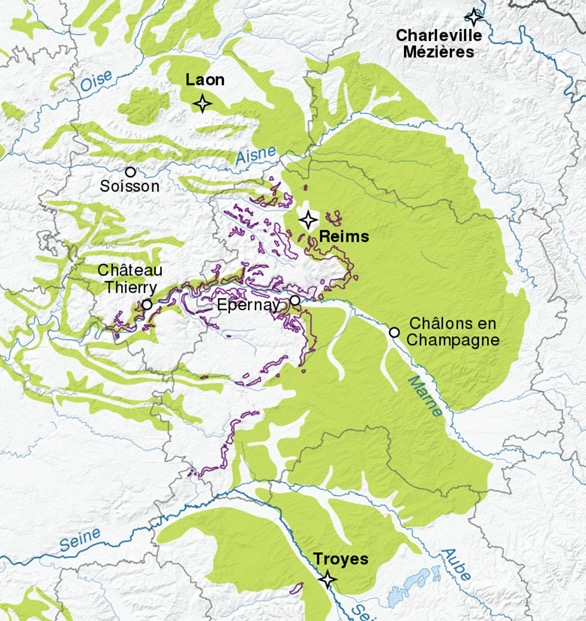
The region Champagne crayeuse is also called Champagne pouilleuse or Champagne sèche, i.e. 'pouilleuse' probably is best translated as lousy and not fertile, and 'sèche' or dry simply in opposition to wet Champagne and suggesting a porous soil. This is the most common type of soil in the Champagne region and is home to the vines needed for Champagne. As the Wikipedia article on the region suggests, a soil that is poor and porous is ideal for Champagne vines. However the reality is that it is a soil that takes well to fertiliser and does retain some moisture, and has been used often for growing cereals, sugar beet, and potatoes. In fact it's porosity means that it becomes a kind of hidden reservoir of water (300 to 400 litres/m3) which allows the vines to draw water during the dry months.
The land is full of slopes, and occasionally you can see chalk outcrops. Initially in the small dips and valleys villages emerged cultivating only the land near streams, etc. The rest of the land was left for sheep farming. In the latter part of the 19th C black pine was planted producing huge forests and the villages appeared to occur in small isolated clearings. Now with machine cultivation and fertilisers, and the loss in 1953-54 of all the rabbits in the forests due to myxomatosis, the forests have been cut down, leaving place for perfectly cultivated landscapes.
The region Champagne humide is in part classed as natural parkland due to the fact that its relatively flat, and the lakes have become popular tourist attractions.
So coming back to our original question, what we see in the distance are small hills and dales. Below we have a detailed view of the 'surface' geology of the region. If you look carefully you can see that each defined area has a small numerical code indicating a type of rock under the surface. We can see Reims sitting on a wide area of chalk (Late Cretaceous).

If we draw a line more or less straight from Reims to Épernay we will find the road D951 that took us from Reims to Champillon. We can see that as we drive out of the centre of Reims we across a dry alluvial river bed. As we drive south we cross large areas of chalk soil interspersed with mixed outcrops of loess, i.e. a kind of wind-blown sediment coming from the erosion of Paris Basin. We are heading towards those darker brown areas. We are going to cross the eastern part of the so-called 'Montagne de Reims'. The idea of a 'mountain' is subjective, and is used to underline a brusk change in altitude, rather than a mountain in the classical sense. It is really more like a wooded plateau, and in fact we will drive through the 'Parc Natural Régonal de la Montagne de Reims'. It is on the southern-facing slopes of this 'mountain' that we find the vineyards of Champagne. This 'mountain' is really just a thick compact blanket of loess, tens of metres thick and covering a vast area. As we come out of the park forest we find Champillon sitting on the southern slope, ideally exposed to the warmth of the sun in the summer months.
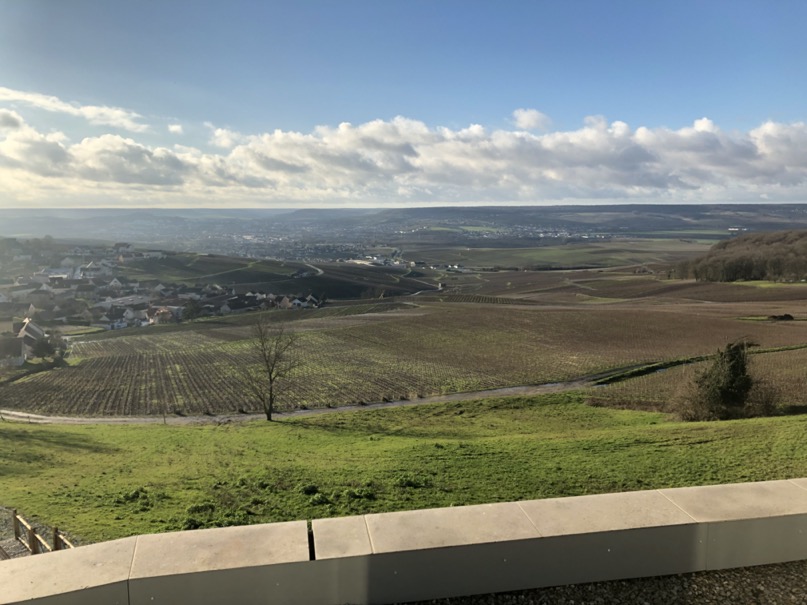
Now can begin to understand better what we are seeing. We can see another wider dry alluvial river bed with the town of Épernay sitting on the far side. And just behind the town we can see again a tree-covered plateau of loess. Because of the nature of the grains that make up loess, vast banks were created that remained intact for considerable periods of time. These loess ridges, that we can see sitting behind Épernay were probably aligned by the prevailing winds during the last glacial period, and in Europe these ridges are often called 'greda ridges'. Below we have a cross-section through a typical ridge in the region.

Whilst the loess can be seen as a superficial deposit they nevertheless have resisted time, and today give the Marne Valley a very contrasted landscape with the smooth, wavy hills and dales of the Champagne region, the region of the lakes, the forests, etc. All created by the local geology.
The old 'Relais de Poste'
Much is made of the fact that the Royal Champagne was once an old Relais de Poste (coaching inn), but what does that mean?
The Romans had a state run courier service (Cursus publicis) and a variety of official postal services were established in European countries in the 15th C and 16th C. In France in the Middle Ages some families were accorded land (a fief) in return for being runners or foot messengers. In 1477 the king of France employed 230 mounted couriers, rich nobles might have 20, and lesser nobles might just have two or three.
The mercantile corporations of Italy had provided the most extensive and regular postal system of this period. Of particular importance were the links maintained from the mid-13th C between the great Italian commercial centres, such as Florence, Genoa, and Siena, and six important annual fairs held in the Champagne region. Two fixed dispatches were made to each of these fairs, the first to carry orders and commissions and the second to effect settlements. The service was carefully regulated. Conditions of acceptance, scales of payment, and timetables were laid down. The routes were fixed, and hostels were maintained along the routes. Since the Champagne fairs were attended by merchants from all over Europe, this postal system provided a valuable international network.
Over time in France the domestic messenger services change from being hereditary functions to being paid services. In 1380 foot messengers were paid between 5 and 10 francs a day to cover 30 km, but in times of war or with the risk of robbery they could be paid as much as 30 francs per day. Riders were paid a flat rate of 18 francs per day for a trip of about 50-60 km, and the horse was provided by their master. Short trips inside Paris could cost less than 1 franc, but long trips with an important and secret message could cost over 1,000 francs. Still in 1620 carrying letters was expensive, e.g. Paris-Rouen would cost 40-70 francs and Paris-Angers could cost 180 francs. During this period messengers could also work under contract, e.g. a fixed price of 38 francs per year for letters inside Paris.
In France Louis XI (1423-1483) set up a Royal Postal Service in 1464, and in England in 1516 Henry VIII (1491- 1547) appointed a Master of the Post to maintain regular postal services. These services were regular but not comprehensive or available to the public. The role of the courier in France was sufficiently important that they were only to use their horses to carry the messages of the king, upon pain of death. Inevitably the security provided along certain routes resulted in unofficial message services being set up in parallel. In 1635 Charles I (1600-1649) made the English Royal Mail service available to the public, and in 1654 Cromwell (1599-1658) granted a monopoly to an 'Office of Postage'. In France the carrying of private mail was legalised in 1600, although the basis of a public service (e.g. fees and timetables) between the larger cities did not emerge until 1627.
By 1500 official letters were constantly moving between the capitals. In some places sworn messengers were used, in North Germany Knights of the Teutonic Order were made commander postmasters, and in South Germany butchers provided a 'butcher post' (Metzger Post). There was plenty of scope for innovation, and London was the first city to benefit from an urban delivery service, when William Dockwra (1635-1716) set up the Penny Post in 1680. He was so successful that he was prosecuted, and his service closed down and then reopened as part of the state postal system. A similar service was opened in Paris in 1759, but it was also quickly absorbed into the state postal system.
Alongside this, in the early 1600's, French local councils, etc. started to certify people of good character as carriers of messages and dispatches. Some towns and cities paid a 'master of messages' to organise regular trips between local towns, etc. In some cities messengers organised themselves into corporations. At times the 'Royal' messengers were in competition with these private messengers, but generally until Louis XIII (1601-1543) there was little overlap between the different types of postal services. So anyone who wanted to transmit private correspondence just had to organise it themselves. In France it was Pierre d'Alméras in 1615 who bought for 2.5 million francs the role of 'général des posts'. As an owner of stables he was able to provide fresh horses and go into competition with messengers using their own horses and travelling more slowly. By 1623 he had organised fixed delivery times between Paris and Bordeaux, Lyon and Toulouse, and he had installed a director of post in each city. He established mail for ordinary letters, leaving and arriving on fixed days, and the service rapidly became a noun with the phrase 'la prochain ordinaire'. In 1624 he had 'maîtres des courriers' in each region and was paying his messengers (so they were no longer controlled by local councils). In 1627 he introduced a general set of postal tariffs, with taxes applied to letters and parcels moving between Paris and Bordeaux, Lyon, Toulouse and Dijon (taxes were proportional to weight and distance). As you can imagine the taxes were not well accepted by the public, since in the past they had the habit of bargaining with the messenger to get the best tariff.
In 1629 the French King replaced the role of 'général des posts' with three 'surintendants généraux des postes' and a network of 'relais de France'. We are not looking to create a complete history of the French postal service, so we can jump forward to when Louis XIV (1638-1715) granted a monopoly over postal services in Paris to Louis-Léon Pagot and Antoine Louis Rouillé. In fact, two different postal systems had slowly evolved. One was the foreign post which included a number of French 'départements' and all the territories occupied by the French armies. The rest was leased to a 'fermier général', the first being Pajot & Rouillé. By 1689 they were established in the 'Hôtel de Villeroy' and through to 1738 they were operating 800 'relais postaux' all over France, and including Venice and Rome. They also exchanged mail with the postal service of the Thurn and Taxis family. Pajot & Rouillé were very secretive. They only used family members as post masters, and they systematically destroyed their records and accounts, etc. every two weeks.
We have to remember that the post was not a frequently used service. In 1693 only 40,000 letters a year moved between France and England, and at about the same time only 40 letters a day were being sent back and forth between Paris and Rome (deliveries twice per month). There was virtually no services between non-neighbouring countries, and many letters were posted through intermediaries, to be then sent on to the final destination. In 1653 Paris had only four mailboxes, including the 'Hôtel des Postes' (in 1716 there were 8 postboxes). Interestingly, tariffs were set by law, but it would appear that everyone was charging more than the official rate. One rate could be written on the letter, and then crossed out and replaced by a higher price to be paid by the recipient. Pre-franking was tried several times, but the clerks would just pocket the money and burn the letters. The 'petite poste' inside Paris was established in 1760 for same-day delivery, and an additional 20 post offices were placed around the capital, with deliveries three time per day.
Interestingly, for the year 1829 more than 1.1 million letters were not delivered in France. About half of them were refused by the addressee, some had unknown addresses, some people had moved without a forwarding address, and 2,000 people had died leaving no next of kin.
In the 18th C the public had a choice between the post and stagecoaches. The cost of the stagecoach prohibited the shipping of small items, and the transfer of money was so expensive that all movements were made by banks (who charged 2% for transfers abroad). We mentioned above that the public mail was leased to a 'fermier général' (the first being Pajot & Rouillé). In fact under the so-called Ancien Régime (ending 1789) post offices were on farms, and sometimes even held by people who would lease a farm so as to obtain the very lucrative post office rents. After the French Revolution there was an attempt to render the post more accessible and democratic, but in the period 1791 to 1801 the number of kilometres made by postal agents on foot, horseback or on carts, had only doubled. Certainly through to the 1830's most smaller towns in France did not have a post office or daily distribution, and rural communities had to be satisfied with weekly deliveries.
So we can see that the 'Maître de Poste' would have a monopoly and with his 'postillons' he would rent out his horses according to an official tariff. There were obligations to always have a night light, and someone in attendance night and day so as not to slow down the mail. The early 'relais de poste' were situated on well defined itineraries. Distances were measured by a 'poste' (about 9 km), a 'demi-poste' and a 'quart de poste'. In 1798 (so after the French Revolution) there were 16 postal routes, including Paris to Mézières via Reims, and Paris to Strasbourg via Châlons-en-Champagne and Metz. Slowly the number of postal routes would rise to 41 before progressively being replaced by the train. However even in 1856 there were still 1,804 'relais de service'.
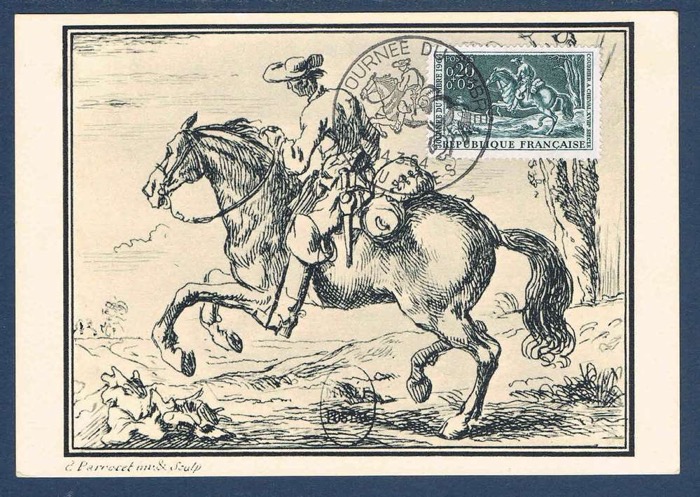
Above we have an example of the mail being delivered by horse and rider in the mid-18th C, whereas passages would have travelled in a 'coche', a basic type of cart designed to carry 6-8 people and pulled by between two and six horses. It started in the 14th C as an open cart, and over time became closed with wood panels and a leather roof. It could be very basic or very opulent, and it would re-invent itself as the stagecoach in the 19th C.

During the period of Louis XV and Louis XVI the 'malle-charrette' was used for the transport of the post (see above). This was a covered 2-wheel cart without suspension usually pulled by 3 horses, one mounted by a 'postillon'. Because of the lack of suspension this type of cart was often named a 'panier à salade' (salad basket).
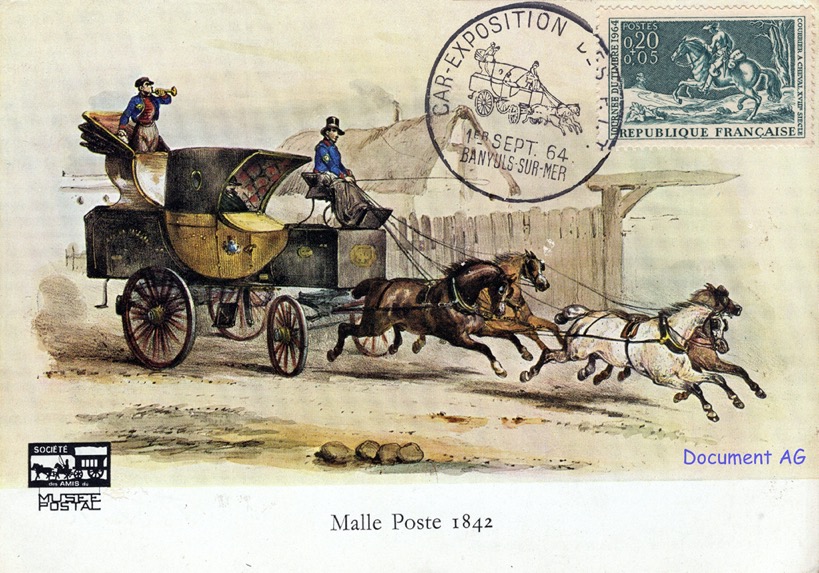
In the 19th C the 'malle-charrette' was replaced by the 'malle-poste', lighter, faster and more comfortable. The 'malle-poste' carried mail and passengers, and was an enclosed 4-wheel vehicle with a spring suspension, pulled by four or five horses. In the front there was the driver and a passenger, in the central part (the coupé) there was space for three passengers, and at the back there was a trunk for the mail. During the Restoration (post-1814) the 'malle-poste' were painted yellow, and later under Louis-Philippe (1773-1850), they were painted grey.
Also the 'diligence' (stagecoach) were used. The stagecoach also had three compartments and five horses, but it was up to 50% slower because it carried more passengers. It would usually have three places in the coupé, six inside, and 2 place on the 'banquette' with the driver (it also cost less for the trip).
Initially the 'malle-poste' and the 'diligence' were driven by a 'postillon' who was attached to a specific 'relais' and carried a metal plaque on his arm with his number and the name of the 'relais'. He would detach the horses at the next 'relais' and walk them back to the starting 'relais'. As mentioned above the distance between one 'relais' and another was about 9.5 km in 1708, but by 1833 it was down to around 7.5 km, however the change of horses had passed from one 'poste' to two 'postes', or about 14.3 km on average. It was in 1827 that a carriage brake was imposed, and so the 'postillon' progressively became the coachman.
Certainly from the 1830's onwards a regular timetable and a set of prices would be offered in all French cities and major towns. There were separate arrangements for the haulage of goods, and even two options were usually available, ordinary haulage and accelerated haulage for valuable or perishable goods.
Neither the 'malle-poste' nor the 'diligence' were comfortable, but slowly each found its purpose. The stagecoach would carry up to 16 passengers, and the 'malle-poste' would carry the post and have 3-4 places for passengers. The 'malle-poste' had priority and could travel at a gallup, but the stagecoach had to travel slowly so as not to destroy the routes used. In fact there were a number of types of vehicle depending upon the number of wheels and horses, and prices varied accordingly.
As mentioned in 1828 one the major problems was that letters could take as long a 8 days to be delivered, particularly outside the bigger cities and towns. So it was decided to employ 5,000 postmen to walk through the 35,000 French communes and perform deliveries at least every two days. At the same time there was an attempt to fix the time it should take to travel from one 'relais' to another. For example, Paris-Bordeaux was to be completed in 48 hours, with 77 'postes' or 'relais' and each link taking around 37 minutes.
I mentioned that one of the main mail routes was Paris to Strasbourg via Châlons-en-Champagne and Metz. There are lists of the post routes dating back at least to 1721, so it is possible to see exactly the route taken and the 'relais' used (I'm using the list from 1778). The trip from Paris to Strasbourg entailed 57 'relais', and the ones that interest us are those before arriving at Épernay. The route passed through Château-Thierry, Paroy, Dormans, Pont-à-Binson, la Cave, Épernay, Jâlons, Matougues, Châlons, … So not through Champillon.
There is plenty of evidence suggesting that public transport was operating on the route Paris to Metz, via Épernay, as early as 1601, and that in 1640 at least three 'relais' were operational (but not in Champillon). By 1775 Épernay was served twice weekly on the route Paris-Strasbourg. A second route Paris-Strasbourg (going south of Épernay) was used on 21 June 1791 when Louis XVI escaped from Paris. On his return trip he is known to have stopped and dined at the 'Brasserie de Rohan' in Épernay. A different set of maps indicate that the route Reims-Épernay was not operational in 1632, but was in 1733 (and may have become marginalised by 1831).
In 1802 a 'Dictionnaire Géographique' was published listing all French post offices, and including 'les Relais de Postes aux Chevaux'. And there we find, amongst the 100's of 'relais', mention of Champillon.
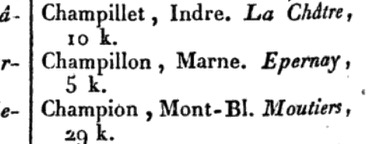
Interestingly in 1833 there was a report that very explicitly stated that there had not been a 'relais' of the 'Poste aux Chevaux' at Champillon, and that no 'relais' existed between Reims and Épernay before the Revolution. This report stated that by 1833 the only 'relais' was at Montchenot (about 16 km from Épernay and 11 km from Reims).
One thing that argues in favour of a 'relais' in Champillon is that in 1789 the route itself between Épernay and Reims (thus passing through or by Champillon) was already made and maintained in stone (whereas the route Épernay-Châlons was still largely just gravel). Naturally the route Paris-Reims was paved by the towns and communes it passed through, but paid by the king.
Did King Charles X of France stop in Champillon?
The claim is that King Charles X (1757-1836) stopped in a Relais de Poste at Champillon before heading toward Reims for his coronation.
I will refer to a book entitled "The Duchess of Berry and the Court of Charles X" which has an extensive description of the his coronation in Reims.
On May 24, 1825, the King left Paris with the Dauphin, Louis Antoine (1775-1844).
They stayed in Château de Compiègne until May 27, 1825.
He left on the morning of the 27th, and slept at Fismes.
On May 28, 1825, he was at Tinqueux at noon, and in the afternoon he made a 'triumphal' entry into Reims.
There is considerable evidence showing that Charles X feasted, hunted, etc. in the Château de Compiègne before finally entering his coronation carriage in Tinqueux.
On May 28, 1825 he spent the night in "his apartments in the Archbishop's palace" (the Palace of Tau).
The King was crowned in Reims Cathedral on May 29, 1825.
On May 30, 1825, Charles X was again in the Cathedral for a ceremony, before naming twenty-one people to the Order of the Holy Spirit, otherwise known as the 'cordons bleus'.
On May 31, 1825, he visited the Hôpital of Saint-Marcoul, before going to the Abbey of Saint Remi.
Still on May 31, 1925, Charles X then went to inspect the troops at a camp at Saint Leonard just under the walls of the city (on the right of the road to Châlons).
Charles left Reims on June 1, 1825, and entered Paris on June 6, 1825.
So it is evident that Charles X did not pass through Champillon on his way to his coronation.
Did Napoléon stay in Champillon?
We appear to be on much solider ground with this affirmation. The French Wikipedia entry for Champillon clearly states that Napoléon stopped in Champillon the day after the Battle of Reims on 12-13 March, 1814.
The general argument is that the Royal Champagne Hotel & Spa was once a Relais de Poste (possible called l'Auberge Neuve), and that after a long uphill climb out of Reims they provided a relay for horses, and food and drink for the drivers and passengers. The Wikipedia entry goes on to say that the day after the Battle of Reims Napoléon stopped there as well.
However, according to the Wikipedia account of the battle, the city of Reims was freed when Napoléon entered the city at midnight of the March 13, 1814. The report goes on to say that Napoléon then spent three days in Reims, sending Michel Ney to seize Châlons. Finally Napoléon decided to move south towards Arcis-sur-Aube, where another battle was fought on the March 20-21, 1814.
According to a different report Napoléon left Reims on the March 17, 1814, and passed through Épernay, Avize, Vertus, la Fère-Champenoise, arriving at Plancy l'Abbaye on March 19, 1814. Champillon is on the main route between Reims and Épernay, and it's not credible that he would have taken an alternative route south.
According to a different text, Napoléon had enough time in Épernay on March 17, 1814, to award the Legion d'honneur to Jean-Rémy Moët, of the famous Moët & Chandon. In fact Napoléon and Moët had been together at the military college in Brienne.
Generally when Napoléon is mentioned, we all think of Napoléon I (1769-1821), but I've seen at least one reference to Napoléon III (1808-1873) who, during a visit to Épernay, expressed a desire to see the 'vignoble' at Champillon. I have not been able to verify this information. But certain references even go on to say that both the Queen Mother of the United Kingdom and President de Gaulle also visited Champillon, and may have even visited the Relais de Poste, which by then had become a 'Relais-Château'. There is a record of de Gaulle visiting Champillon (23 April 1963) during a trip to the Champagne-Ardenne and Moselle (22-28 April 1963).
And now who are these horsemen?
Inside the hotel a figure on horseback is used extensively as one of the major decorative themes in the hotel, but what does it represent?
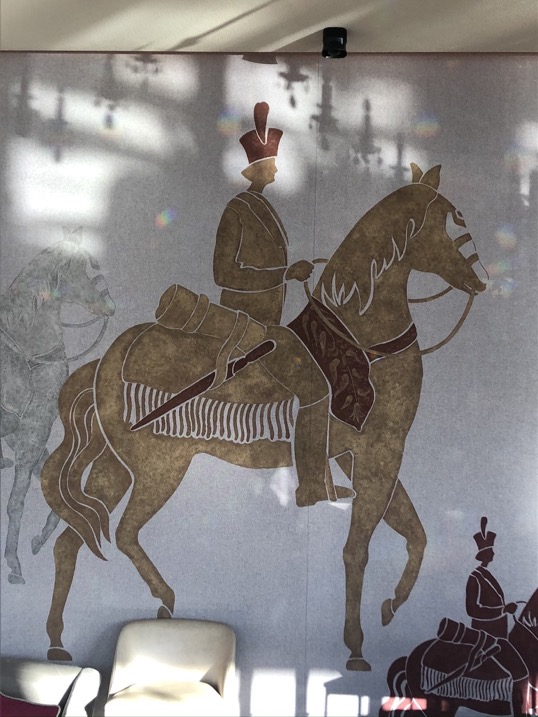
According to one of the many 'press briefings' on the hotel, the above decorative theme was created by Cécile Gauneau, as a tribute to the regiments of the French Royal Army under the Ancien Régime (that is until 1789). Frankly I was left a little perplexed by both the funny shaped hat and the odd looking weapon(?) attached to the saddle or blanket.
Hunting around a bit I came across the fact that once the Champagne region had its own regiment. It all started with Charles V (1338-1380) who in 1373 created a professional army. It took the form of 'compangnies de gendarmes', or cavalry units of a hundred men commanded by a 'captaine'. In peacetime these formations were dismissed and the result was that the country was infested with adventurers and plunderers who became a national plague.
Charles VII (1403-1461), by ordinances of 1439, 1445 and 1446, created a national and permanent army. Only the king had the right to raise troops, which he maintained in both war and peace. The 'gendarmerie' was reduced to 15 companies on horseback. Each was one hundred men or so-called 'lances garnies' (men-at-arms), along with three archers, a couturier, and a varlet. All were on horseback but fought on foot.
In 1480 Louis XI (1423-1483) replaced this militia by groups of 1,000 men, halberdiers and pikemen, recruited when necessary and paid by the regime. This allowed him to ban private armies of the nobility. In the reign of Louis XII (1462-1515), these groups were captained by nobles.
In 1534, François Ier (1494-1547) tried the idea of provincial 'légions' each of around 6,000 men. These 'légions' were soon suppressed but the men remained. Transformed into permanent units they became the backbone of the French infantry. Each unit was commanded by a captain/owner, and each was recruited in the provinces. All were under the command of François de Bourbon (1491-1545), count of Saint-Pol. Those of Picardy, of Piedmont and Champagne were the first (1535) and were named the 'vieilles bandes'. In 1542 Admiral Gaspard II de Coligny (1519-1572) was appointed colonel-general, and in 1544 he installed a regime of legendary severity. Looters were punished by death and it is said that they hung "from the branches of trees more than birds".
In 1558, Henri II (1519-1559) abandoned the 'légions', but confirmed the geographical principle of recruitment. So all the officers and most of the men should belong to a province, and should take that name. During the reign of Charles IX (1550-1574) discipline became weak. The soldiers, although serving as regular troops, committed atrocities reminiscent of the adventurers of the 14th C. Normally housed and fed by locals in wartime, they often imposed on them in peacetime. The reform was the work of Catherine de'Medici 1519-1589). She appointed Philippe Strozzi (1541-1582) as colonel-general of the infantry. In May 1569 he reorganised completely the French army. Regiments were created for the French Guards, Swiss Guards, Picardie-Infantry, Champagne-Infantry, Piedmont-Infantry and Navarre-Infantry. These were the 'vieilles bandes' and they were followed by the 'moyens vieux' and the 'petits vieux'. Initially these regiments were few and mostly cavalry, but through the second half of the 17th C the infantry became predominant until in 1769 it was recognised that "cavalry is very useful in supporting infantry but the infantry is the most important and most considerable of the armies in Europe".
Provincial names were assigned to infantry regiments, and from 1761 also to cavalry regiments. The names referred to the region in which the men was recruited. The two regiments of Champagne, one of infantry, the other of cavalry, were only occasionally garrisoned in Champagne.
The Champagne-Infantry likes to date it's creation back to 1534 with the 'Légion de Champagne', but it was in 1552 that it forged its character when they participated in the defence of Metz. However it was after the re-organisation of 1569 by Philippe Strozzi that the Champagne-Infantry was classed as France's third most important infantry unit. It consisted of 26 companies, four from the King's Guard and 22 from the Champagne region (so 2,000 men). The soldiers were pikemen and 'arquebusiers'.
This is not the place for a detailed history of the Champagne regiments. What is interesting is that 'Les Régiments de Champagne sous l'Ancien Régime' is available on Gallica on the BnF website. And on the cover of that book we have a poor image, which looks to have been the 'inspiration' for Gauneau's decoration.

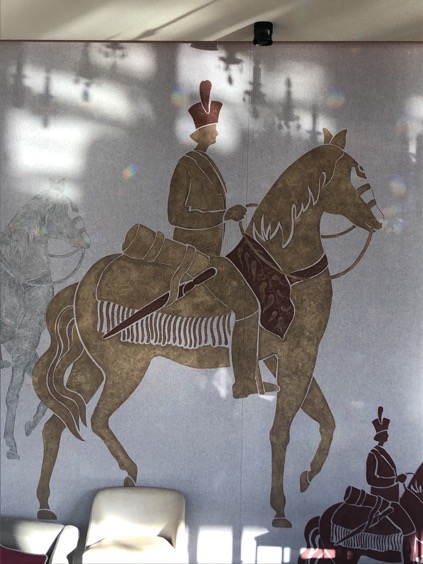
Frankly, the more I look at Gauneau's decoration, the more I'm disappointed.
Wikipedia has a short entry on the 'Régiment de Champagne', where the essentials are listed. Later this regiment was known as the '7e Régiment d'Infanterie'. There is a nice historical review here, however most of the references on the web appear to point back to the book found on Gallica.
And finally who is this?
On the outside wall of the old Relais de Poste there is a painting of a soldier, but what exactly does that mean?

I'm really at a loss to place this uniform. Blue with the white crossed belts is typical of the French light infantry ('legere-chasseur' or 'infantry of the line') but the hat, the weapon, the general costume appearance, and shoes and buckles are completely wrong (and the blue should be much darker).


Fortunately the flag can help. During the Hundred Years' War (1337-1453) the English would use the Red Cross of St. George, and the French would answer back with the white cross of St. Michel ('Croix de Saint Michel'). There is a famous French song called the 'Ballade du Sacre de Reims' which praised the glory of Charles VII in 1429. I've not been able to find much on this 'ballade', but the phrase "Vive la croix gente, blanche et hautaine/Du beau jardin des nobles fleurs de lis" is used to justify the importance of the cross of St. Michel. In the 16th C and 17th C this white cross on a blue background would be reserved as the flag for French civilian merchant ships. Again the story is complicated. It would appear that 'before Richelieu' (so sometime before 1616) French provincial admirals used all sorts of banners, standards, signs, etc. on their ships. At this time ships were owned by individuals, lords, governors, or merchants. Flags with crosses date from the Crusades (11th C to 13th C), and they were hoisted to show safe ports. It would appear that a blue flag with a white cross was used as early as 1643 (or earlier) by both the French navy and merchant ships. It was Richelieu who had introduced the white flag (a sign of purity) for the French king's navy (it was abolished in 1748). An ordinance of 1661 prohibited French merchant ships from flying the white flag, and instructing them to fly the 'l'ancien pavillon de la nation française', i.e. a white transversal cross on a blue fabric (sometimes set with the arms of the French king in the centre).

This practice was formalised in 1670, but due to the stubbornness of the merchants they continued to carry the white flag, until the adoption of the 'tricolore' in 1794.
We know that numerous regiments in the French army also adopted the white cross of St. Michel. So let's look at the hat.
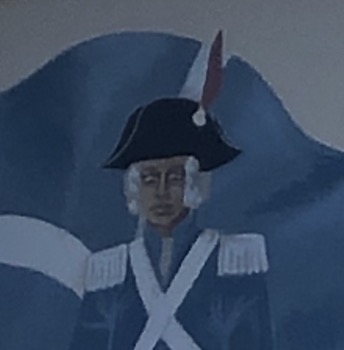
Firstly it looks to be a bicorne (cocked hat), as opposed to a tricorne, but the viewing angle might be deceptive. It also is worn with what looks like a red feather, rather than a cockade. Worn side-to-side (athwart style) is typical of the 1790's, whereas later it was worn front-to-back. I've never seen a bicorne with a long thin red feather, although a short red feather was used by the 18th C French grenadiers. They had a dark blue jacket, crossed white straps, but with red epaulets. A very similar uniform (no epaulets) was worn by American forces during the their Revolutionary War (1775-1783). See below for the American Blue Coat, with next to it the uniform of the Champagne-Infantry ca. 1735.
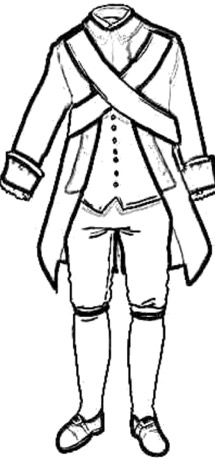

I've tried my best to find such a uniform, but it just does not look like something from the French army. Below we can see an image often found on the Web of a Champagne infantryman, ca. 1750.
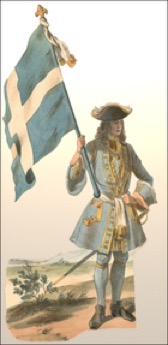
You can easily see that this might have been the inspiration for the picture on the hotel's exterior wall, but the only problem is that due to a colour shift, the blue flag should have been green. In fact the Champagne regiment flag was green with a white cross. I don't know if I will ever get round to finding out the true origin of the picture. Always nice to leave a question open for our next visit to the region.